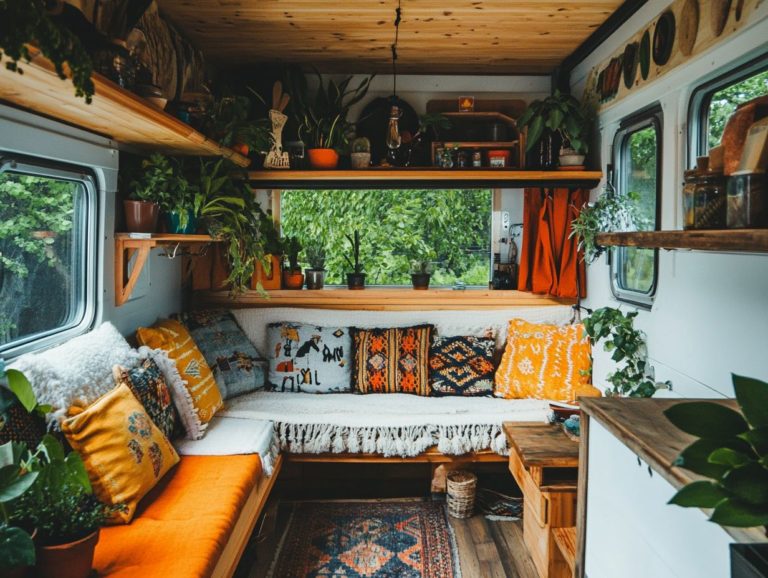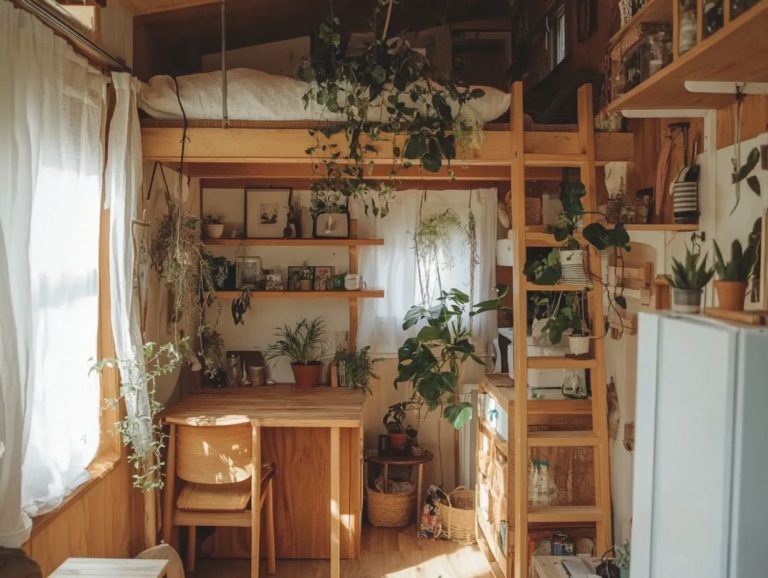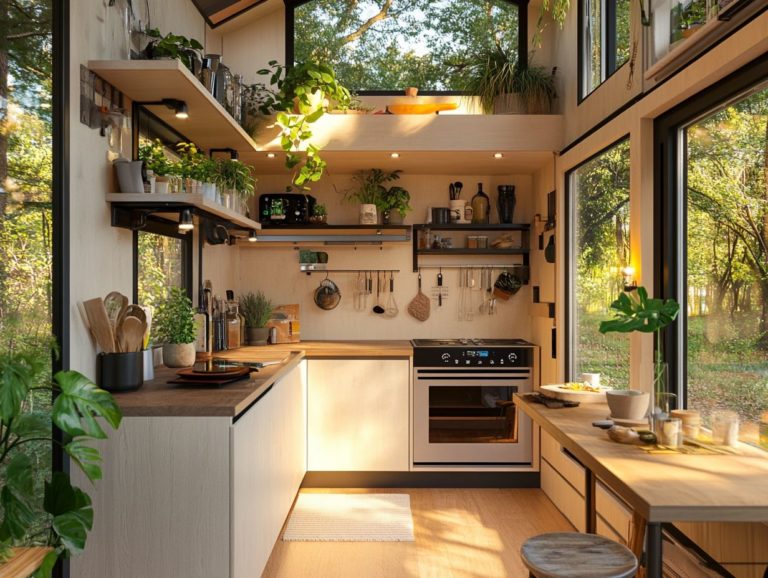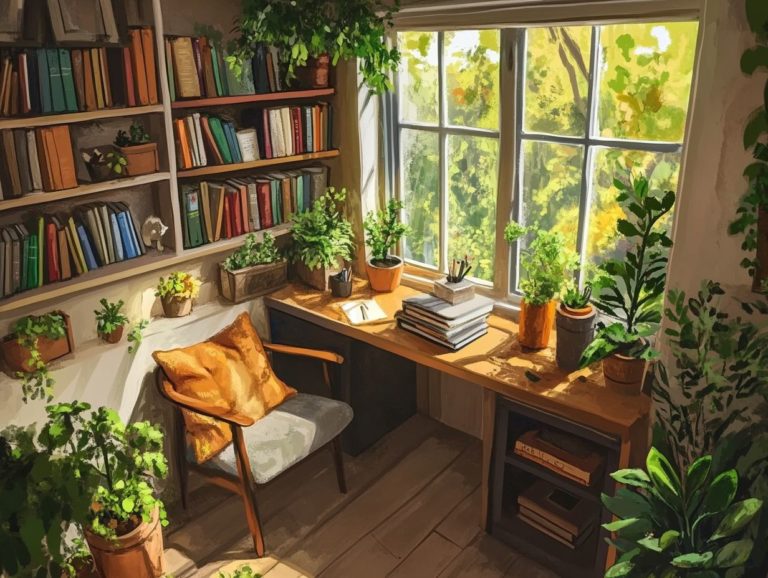DIY Tiny House Renovation Success Stories
Embracing the tiny house movement presents a remarkable opportunity for you to transform small spaces into functional and stylish homes.
This article explores effective strategies for maximizing your limited square footage. You’ll discover innovative storage solutions and budget-friendly renovations.
Learn how to add personal touches, integrate sustainable practices, and design multi-purpose rooms that fit your lifestyle.
With insights on overcoming challenges and enhancing your living space with technology, you’ll find the inspiration to embark on your tiny house renovation journey.
Contents [hide]
- Key Takeaways:
- 1. Turning a Small Space into a Functional Home
- 2. Creative Use of Space and Storage Solutions
- 3. Cost-Effective Renovations
- 4. Personal Touches and Customizations
- 5. Sustainable and Eco-Friendly Design
- 6. Multi-Purpose Rooms and Furniture
- 7. Incorporating Natural Light and Outdoor Spaces
- 8. Upcycling and Repurposing Materials
- 9. Making the Most of Vertical Space
- 10. Utilizing Technology for Efficient Living
- 11. Transforming Old and Dilapidated Structures
- 12. Collaborating with Friends and Family
- 13. Budget-Friendly DIY Projects
- 14. Creative Tiny House Designs
- 15. Overcoming Challenges and Learning Lessons
- How to Get Started with Your Own Tiny House Renovation?
- Frequently Asked Questions
- 1. What are some key tips for a successful DIY tiny house renovation?
- 2. Can you share a real-life success story of a DIY tiny house renovation?
- 3. How can incorporating eco-friendly elements contribute to a successful DIY tiny house renovation?
- 4. What are some common challenges faced during a DIY tiny house renovation and how can they be overcome?
- 5. Do you have any tips for successfully managing a DIY tiny house renovation project?
- 6. What are some benefits of DIY tiny house renovation projects compared to hiring professionals?
Key Takeaways:
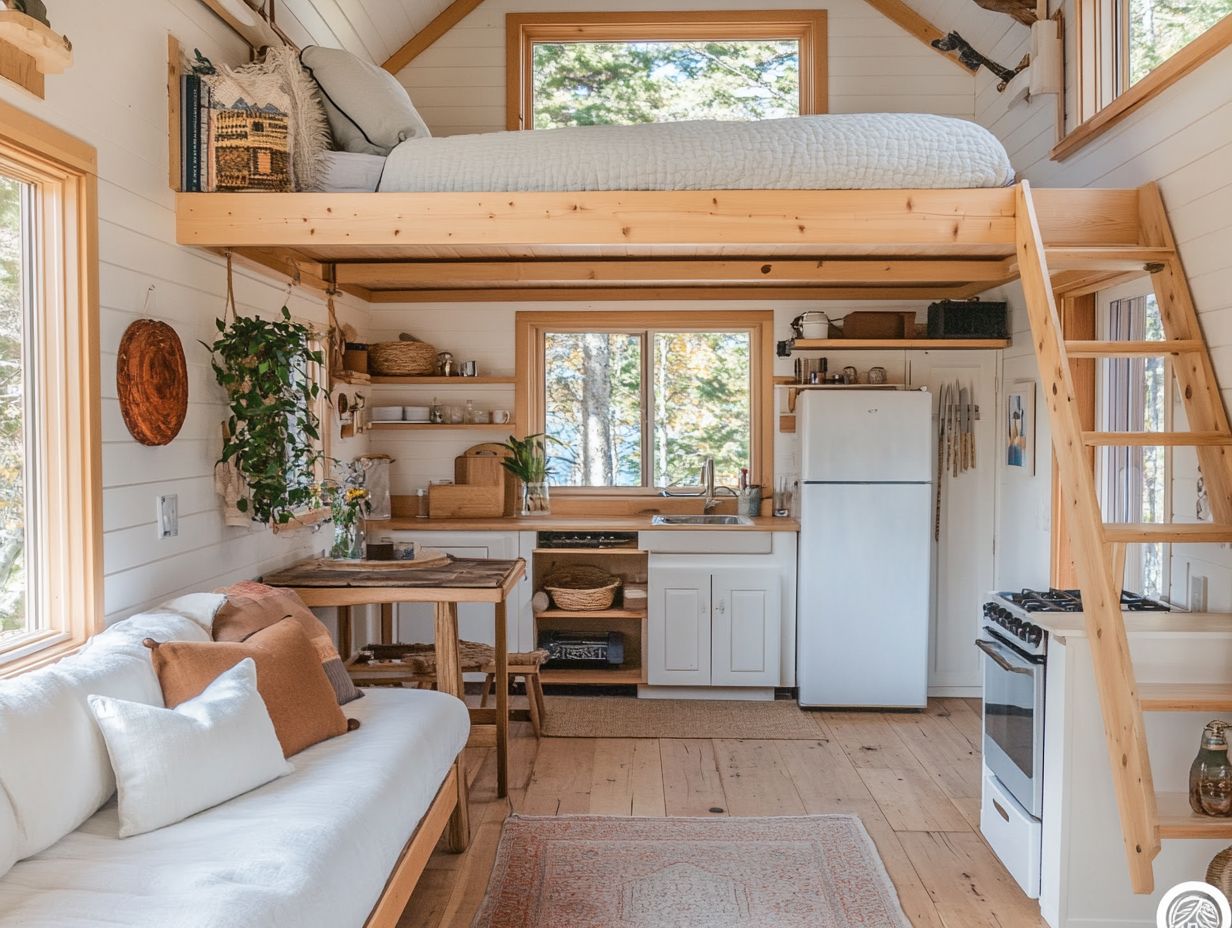
- Transforming a small space into a functional home requires creativity and resourcefulness.
- Innovative storage solutions make your tiny house feel open and organized!
- Cost-effective DIY renovations allow for personal touches and unique customizations.
1. Turning a Small Space into a Functional Home
Transforming a small space into a functional home is a rewarding challenge. It embodies the essence of living with only what you need while guiding you toward financial freedom and success in tiny housing.
By embracing the tiny house movement, you can design a living space that is efficient and comfortable. This involves prioritizing essential design elements that promote sustainable living and community building.
Get ready to downsize and embrace a more intentional lifestyle! This journey encourages you to curate your belongings, emphasizing quality over quantity.
This shift not only liberates your financial resources but also sparks your creativity in maximizing every inch of space. Think multi-functional furniture and clever vertical storage solutions that make every square foot count.
You ll likely be drawn to communities that share your values, creating enriching connections. These groups often advocate for eco-friendly practices, such as using reclaimed materials and renewable energy sources, reinforcing your commitment to sustainability.
These choices reflect a lifestyle that champions personal fulfillment and a collective vision for a harmonious existence.
2. Creative Use of Space and Storage Solutions
Creative use of space and innovative storage solutions are crucial for maximizing the functionality of your tiny house. This enables you to fully embrace minimalist living.
By incorporating versatile design elements like multi-purpose furniture, you can effortlessly transform rooms for various activities without sacrificing comfort or aesthetics. Imagine a fold-out table serving as a dining area, workspace, or extra counter space in your kitchen!
Clever storage solutions, such as under-stair drawers or wall-mounted shelves, help you declutter while maintaining order.
Many DIY enthusiasts craft hidden compartments within benches and design lofted beds to free up floor space. This way, every square inch of your home is utilized effectively, all while keeping style firmly in the picture.
3. Cost-Effective Renovations
Cost-effective renovations are fundamental to achieving financial freedom while building your tiny house. Every investment should enhance your living experience without straining your budget.
By meticulously planning budget-friendly DIY projects, you can transform your small space into a beautifully functional home. Consider tips for a DIY tiny house exterior makeover that focus on renovations offering the highest return on investment, such as energy efficiency, aesthetic appeal, and practical functionality.
Employ smart budgeting strategies like sourcing reclaimed materials and participating in community workshops for skill training. Your commitment to tasks like painting, landscaping, or crafting custom furniture not only saves money but also adds a personal touch that enriches your home s character.
Start planning your tiny house renovation today and enjoy the freedom of minimalist living!
4. Personal Touches and Customizations
Incorporating personal touches and customizations into your tiny home is essential for achieving success in this lifestyle. It allows you to express your individuality while maximizing comfort and functionality.
Every choice you make, from selecting a warm color palette that resonates with your personality to opting for multifunctional furniture, transforms your compact space into a true reflection of your lifestyle. For instance, a vibrant accent wall can evoke energy and inspire creativity. Meanwhile, neutral tones can create a serene atmosphere for relaxation.
Adding bespoke shelving or a unique dining table not only optimizes space but also infuses character into your living area. These design elements are crucial not just for aesthetics but for crafting an environment where you can truly feel at home.
They foster a sense of belonging and warmth in every corner, making your tiny home a sanctuary that reflects who you are.
5. Sustainable and Eco-Friendly Design
Sustainable and eco-friendly design principles lie at the heart of the tiny home movement. They encourage a lifestyle that embraces minimalism while honoring the environment through thoughtful choices.
This approach emphasizes the importance of reducing your carbon footprint while also promoting the use of sustainable materials. These practices ultimately lead to healthier living spaces.
By opting for reclaimed wood, bamboo, and recycled metal, you align seamlessly with the values cherished by the tiny home community. These choices resonate with those who aspire to live simply, minimize waste, and forge a deeper connection with nature.
All while nurturing a sense of responsibility toward the planet. By integrating these eco-friendly practices into every build, tiny homeowners like you actively contribute to a movement that prioritizes sustainability and environmental stewardship.
6. Multi-Purpose Rooms and Furniture
Incorporating multi-purpose rooms and furniture is essential in your tiny home. This approach allows you to embrace a lifestyle of simplicity while maximizing your available space for diverse activities.
Imagine your combined living and dining area effortlessly transforming from a cozy spot for meals into a comfortable lounge for relaxation at the end of the day! This is all thanks to a foldable table and stackable chairs.
Similarly, a wall bed can liberate precious floor space during the day. It can turn your bedroom into a functional office or exercise area.
These versatile designs not only enhance usability but also create an environment where functionality harmonizes with aesthetic appeal. This ensures that every inch of your tiny home serves a purpose.
This thoughtful approach ultimately enriches your living experience, making the most of your unique space.
7. Incorporating Natural Light and Outdoor Spaces
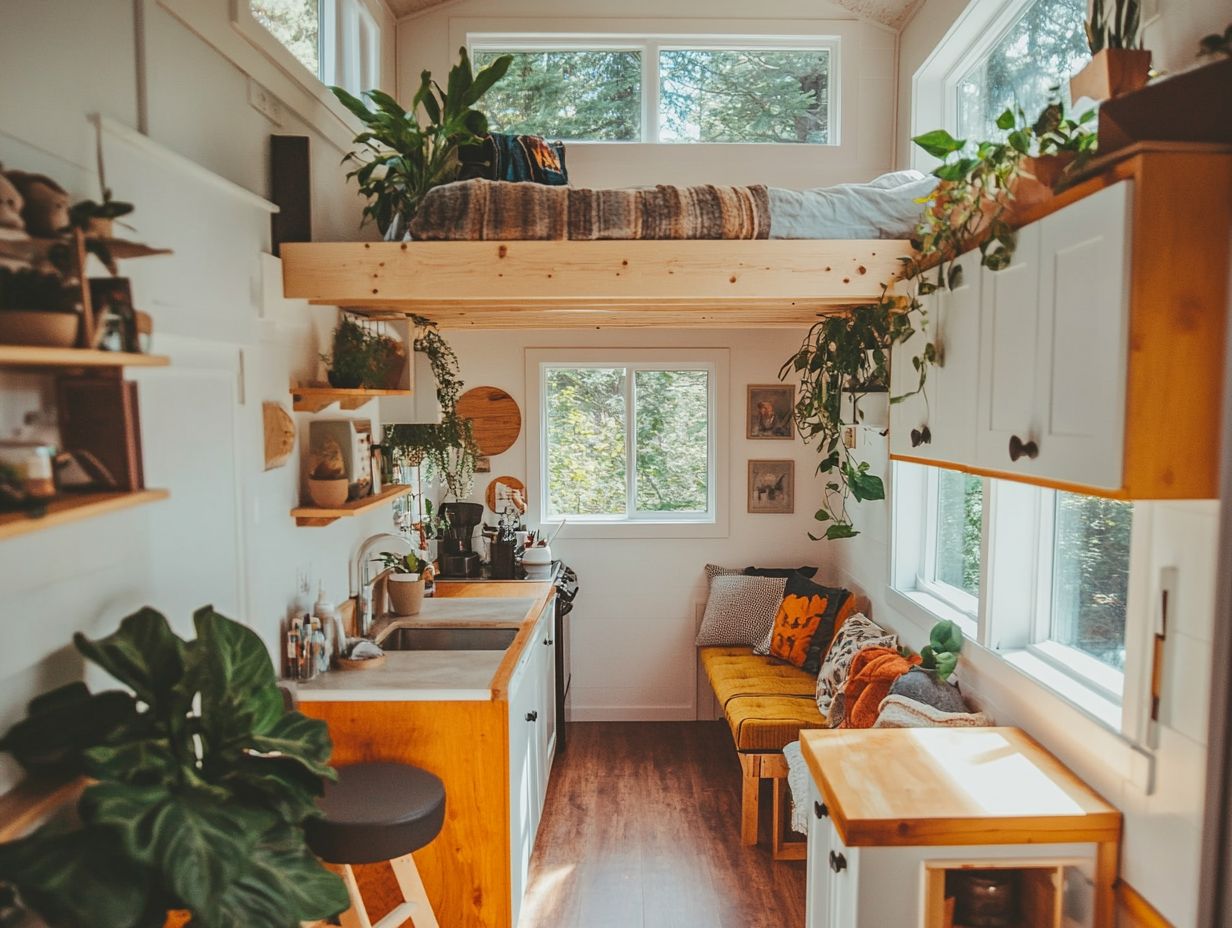
Incorporating natural light and outdoor spaces into your tiny home design elevates the aesthetic appeal. It champions sustainable living by creating a harmonious flow between your indoor and outdoor environments.
This thoughtful integration can significantly enhance your mood, crafting an inviting ambiance that nurtures relaxation and sparks creativity.
Imagine large, strategically positioned windows or glass sliding doors that open directly onto a patio or garden area! They allow sunlight to pour into your interior spaces while granting effortless access to fresh air.
These features seamlessly connect your home with nature and provide opportunities for enjoyable activities. Whether it s practicing morning yoga or inviting friends over for coffee, thoughtful design elements like overhangs or trellises can help manage light exposure.
This ensures your comfort throughout the day. Transform your living space now and enjoy the benefits of a personalized tiny home!
8. Upcycling and Repurposing Materials
Upcycling and repurposing materials not only present exciting D.I.Y. projects but also resonate with eco-friendly habits. They offer unique solutions to enhance your tiny house creatively.
Imagine transforming old wooden pallets into chic furniture or using glass jars for eco-friendly storage. These simple changes can significantly elevate the aesthetic of your small living area. Dive into these creative projects to save money and make your home shine!
By opting for eco-friendly materials like reclaimed wood or biodegradable fabrics, you ll enhance your projects even further. These practices foster a deeper appreciation for resourcefulness and creativity, helping you cultivate a lifestyle that prioritizes the health of our planet while beautifying your personal space.
9. Making the Most of Vertical Space
Optimizing vertical space in your tiny house is essential for maximizing your living areas while embracing a simple lifestyle without compromising on comfort or functionality.
This approach opens the door to creative solutions tailored to your unique lifestyle. Consider incorporating shelving units that stretch toward the ceiling. They can provide ample storage for books, decor, or plants, transforming a simple wall into a visual delight.
Lofted beds are another clever way to free up floor space, allowing for a desk or a cozy seating area below especially beneficial if you work from home. Wall-mounted storage options, like hooks or cubbies, can adapt to your needs, helping you organize kitchen utensils or showcase cherished items. This ensures every inch of your space is utilized effectively and stylishly.
10. Utilizing Technology for Efficient Living
Using technology in your tiny house can elevate your living experience. It offers solutions that streamline daily tasks and enhance your overall quality of life in a compact space.
This becomes vital as you navigate the unique challenges of limited square footage, which means having restricted space to work with. Smart home devices enhance comfort and save energy, from automated lighting to climate control systems.
Energy-efficient appliances, like compact refrigerators and induction cooktops, maximize functionality while reducing your carbon footprint. By embracing these innovations, you can achieve a balance between modern conveniences and sustainable living, proving even smaller spaces can be livable and environmentally responsible.
11. Transforming Old and Dilapidated Structures
Transforming old and dilapidated structures into tiny houses is an exhilarating D.I.Y. project that requires careful attention to building codes, which are rules that ensure safety in construction.
Your journey begins with a thorough assessment of the existing building to evaluate its structural integrity, ensuring that walls, beams, and foundations are robust enough to support your new design. You ll also need to navigate local building codes, which dictate permissible renovations and safety measures think of them as the rules of the game.
Reimagining the layout often involves optimizing limited square footage and incorporating sustainable materials, turning once-neglected areas into functional living spaces. By blending innovative design techniques with respect for the original architecture, your renovations won t just preserve the past; they ll contribute to contemporary living, creating unique homes brimming with character.
12. Collaborating with Friends and Family
Collaborating with friends and family on your journey to build a tiny house fosters a sense of community and creates lasting relationships as you embark on exciting DIY projects together.
This collective effort enhances your overall experience. You can pool skills and ideas for a more innovative design approach.
As you share the labor, tasks like framing and painting become opportunities for bonding, with each participant contributing their unique talents.
Many tiny home enthusiasts have initiated community workshops and group builds where individuals come together to share knowledge and resources. These initiatives often lead to new friendships and a vibrant support network.
Successful tiny house projects become more than just homes they serve as building blocks of community spirit, creating lasting relationships that lead to financial freedom.
13. Budget-Friendly DIY Projects
Engaging in budget-friendly DIY projects is a savvy approach to achieving financial freedom while building or renovating your tiny house.
These projects unleash your creativity and save money, which can accumulate quickly when hiring professionals.
By tackling tasks like installing shelves, painting walls, or crafting custom furniture, you can save a considerable amount. There s unique satisfaction in creating something with your own hands.
Exploring various DIY possibilities helps you manage your budget effectively while enhancing your living environment.
Embracing the DIY mindset opens the door to creativity and connection with your home!
14. Creative Tiny House Designs
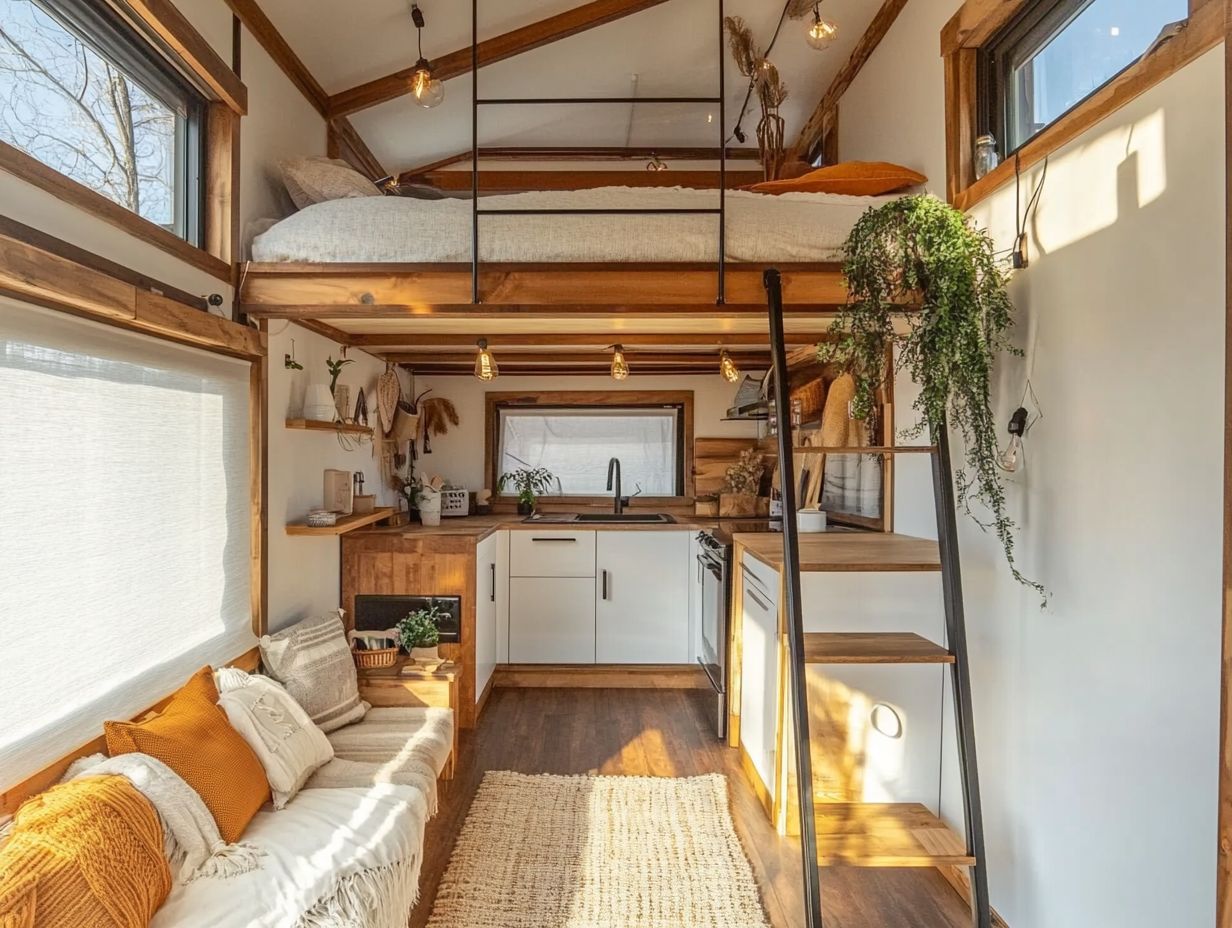
Creative tiny house designs captivate with their visual appeal while maximizing functionality.
These designs suit various lifestyles. They seamlessly integrate outdoor recreation into your daily routine.
Thoughtfully crafted, these spaces often feature large windows and open-air layouts, beautifully blurring the lines between your indoor haven and the vibrant world outside.
This design philosophy enhances the sense of freedom that comes with smaller living. Many homes boast patios, sliding doors, and multi-purpose furniture.
In communities where tiny homes are clustered, you ll often find shared gardens, communal fire pits, and workshop spaces. These features inspire creativity and exploration in everyday life.
15. Overcoming Challenges and Learning Lessons
The tiny house journey presents a myriad of challenges, each offering invaluable lessons that transform you into a resourceful individual.
For instance, one homeowner shared their struggle with downsizing, which means reducing the number of belongings you have. This process revealed emotional attachments and practical insights about the true value of material possessions.
Over time, they discovered that letting go not only lightened their physical burden but also enriched their appreciation for what genuinely matters relationships and experiences.
This sentiment resonates throughout the tiny home community, where many recount similar transformative stories. These experiences reflect a broader movement that champions simplicity and intentionality.
Invite yourself to redefine your lifestyle and discover fulfillment beyond conventional norms.
How to Get Started with Your Own Tiny House Renovation?
Getting started with your own tiny house renovation requires a clear understanding of your tiny house dream and a methodical approach to crafting your ideal space. Whether you re building from scratch or repurposing an existing structure, clarity is key.
To lay the foundation for a successful transformation, reflect on your lifestyle goals and needs. This process begins with envisioning how the tiny space will serve you, considering factors like design, functionality, and sustainability.
Next, meticulous planning takes center stage. Set a realistic budget that encompasses materials, labor, and potential unforeseen expenses. Gathering the right resources from skilled tradespeople to eco-friendly building supplies can streamline your renovation journey.
By defining these aspects early on, you can avoid common pitfalls and make informed decisions that align with your vision.
What Are the Essential Considerations for a Successful Tiny House Renovation?
When embarking on a tiny house renovation, consider these key factors:
- Understanding local building codes
- Defining your space requirements
- Selecting eco-friendly materials that resonate with your lifestyle aspirations
Don t overlook the importance of obtaining the necessary permits to ensure compliance with regulations. This foresight can save you both time and frustration down the road.
Thoughtful space optimization can transform compact areas into functional and aesthetically pleasing zones, where every square inch serves a purpose.
Incorporating eco-friendly choices fosters a healthier environment and can also lead to significant cost savings in energy usage and maintenance over time. By balancing these elements, you can create a harmonious living space that reflects your personal values while optimizing for both comfort and efficiency.
What Are the Common Mistakes to Avoid in Tiny House Renovations?
Avoiding common mistakes in tiny house renovations is essential for a smooth process and successful outcomes, especially regarding space planning and budgeting.
Many homeowners underestimate the costs involved in renovations, leading to financial stress and unfinished projects. Neglecting local building codes and regulations can result in legal complications and unexpected expenses.
To successfully navigate these challenges, do your homework on materials, hire trustworthy contractors, and create a comprehensive budget that includes a contingency fund for unexpected costs. Consulting with local authorities can provide valuable guidance on zoning requirements and permits, ensuring that all modifications comply with regulations while maximizing your limited living space. For those looking to transform their space affordably, consider checking out this DIY tiny house renovation on a budget.
How Can a Tiny House Renovation Benefit Your Lifestyle?
A tiny house renovation can elevate your lifestyle, embracing the ideals of financial freedom, minimalism, and a deeper connection to both community and nature.
By simplifying your living space, imagine reducing your monthly expenses, freeing up resources for thrilling adventures! This downsized lifestyle often leads to more quality time outdoors, where you can engage in recreational activities like hiking, gardening, or simply soaking in the beauty of nature.
Living in a compact community nurtures closer relationships with your neighbors, creating a supportive atmosphere where sharing resources and skills becomes second nature. This enriches social connections and promotes a vibrant, cohesive neighborhood dynamic that makes life all the more fulfilling.
Start planning your tiny house renovation today and embrace a simpler lifestyle!
What Are the Legal and Zoning Considerations for Tiny House Renovations?
Know the legal and zoning rules for tiny house renovations. This knowledge helps you stay compliant and avoid pitfalls that could derail your dreams.
Navigating these regulations might feel overwhelming at first. However, getting familiar with local area regulations can make the process much smoother. Many municipalities have specific requirements regarding minimum square footage, foundation types, and even utility connections that you need to know.
To make informed decisions, start by visiting local government websites. There, you can typically find zoning information and building codes. Engaging in tiny house forums or local community groups can also provide you with invaluable insights and experiences from others who have tackled similar challenges.
Keep up with changing regulations. Local policies shift often and may impact your renovation plans.
Frequently Asked Questions
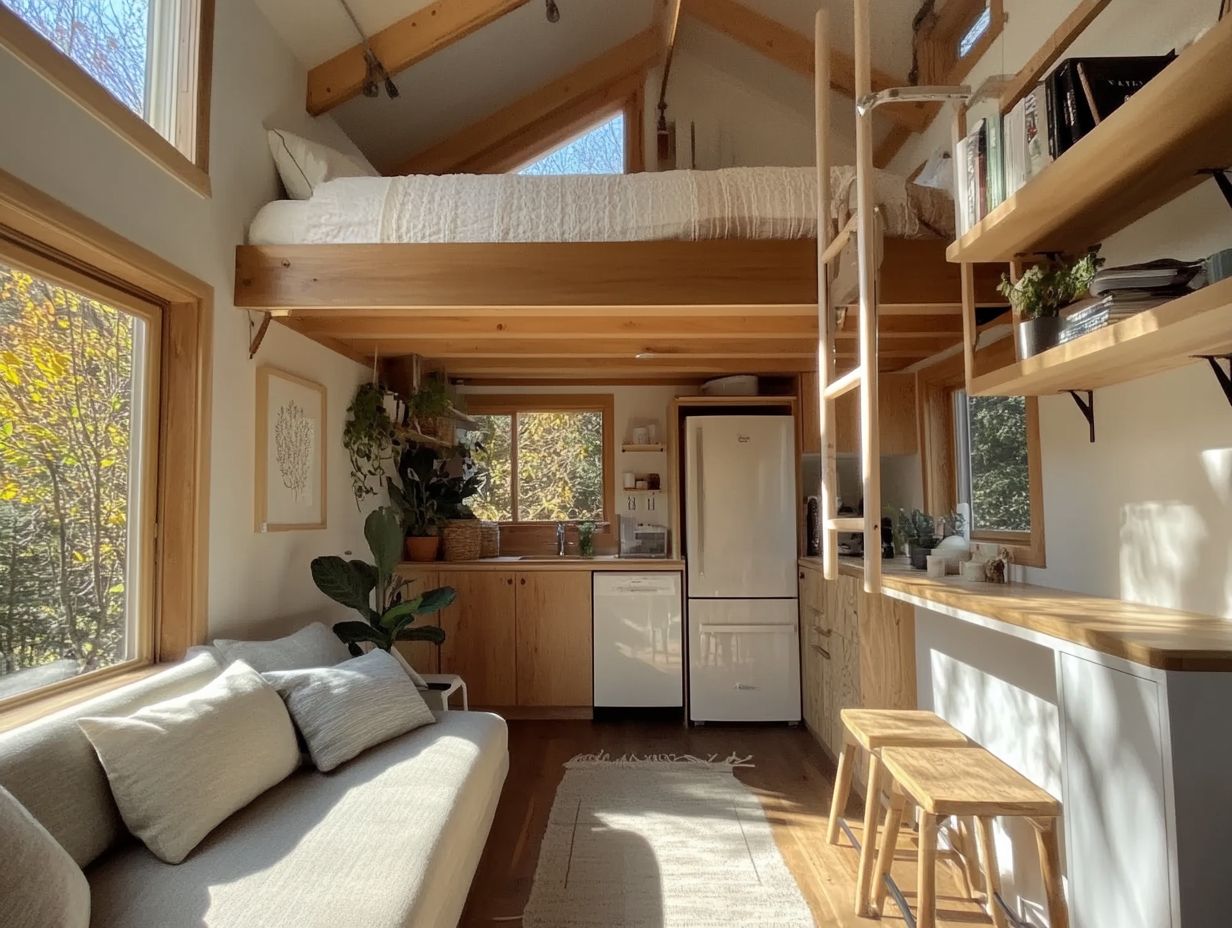
-
1. What are some key tips for a successful DIY tiny house renovation?
Key tips include:
- Having a solid plan
- Setting a realistic budget
- Using quality materials
- Being prepared for unexpected challenges
-
2. Can you share a real-life success story of a DIY tiny house renovation?
Yes! One success story involves a couple who transformed an old school bus into a stylish tiny home on wheels. They managed most of the renovation by themselves and now live in their dream home debt-free.
-
3. How can incorporating eco-friendly elements contribute to a successful DIY tiny house renovation?
Incorporating eco-friendly elements such as renewable energy sources and sustainable materials reduces environmental impact. It can also save money in the long run and add value to the tiny house, aligning perfectly with the ethos of the Earth Day festival celebrated in places like Santa Barbara.
-
4. What are some common challenges faced during a DIY tiny house renovation and how can they be overcome?
Common challenges include:
- Limited space
- Obtaining necessary permits
- Staying within budget
These can be overcome through careful planning, seeking advice from experts, and being open to alternative solutions.
-
5. Do you have any tips for successfully managing a DIY tiny house renovation project?
A few tips include:
- Staying organized
- Setting priorities
- Seeking help when needed
- Taking breaks to avoid burnout
-
6. What are some benefits of DIY tiny house renovation projects compared to hiring professionals?
Saving money is a major benefit. You also gain satisfaction and pride from creating a unique and personalized home. DIY allows for more creative freedom and the chance to learn new skills.
Ready to start your own tiny home adventure? Let s get building!

